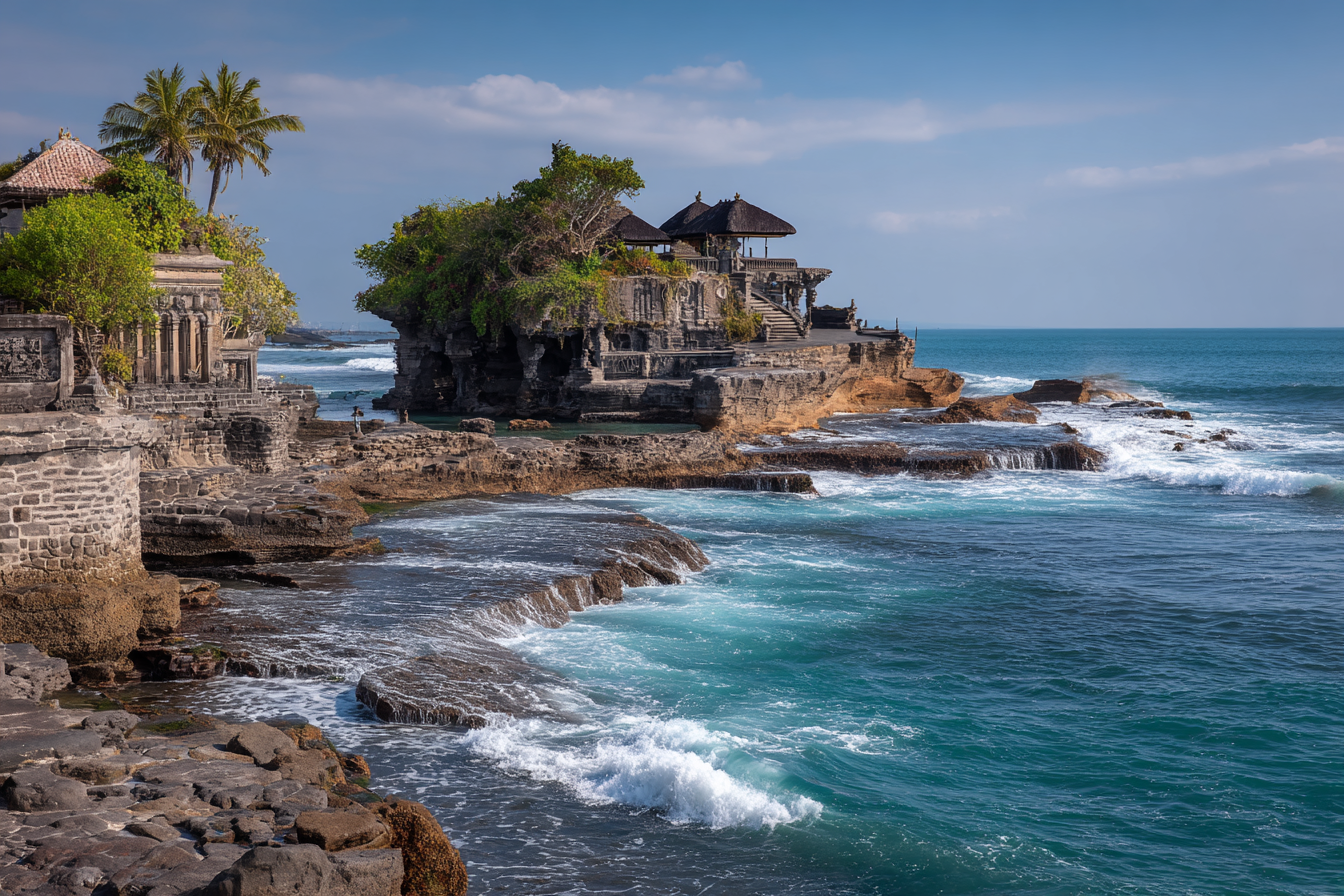Tanah Lot Temple is one of Bali’s most iconic landmarks, famous not only for its breathtaking seaside location but also for its distinctive architectural style that beautifully illustrates the island’s rich cultural and religious heritage. Nestled on a dramatic rock formation that juts out into the ocean, this temple captures the imagination of visitors through its harmonious blend of natural setting and intricate design elements emblematic of Balinese spirituality. Exploring the architecture of Tanah Lot Temple unravels a story of craftsmanship, symbolism, and environmental interplay that continues to inspire travelers and devotees alike.
Balinese Temple Architecture: An Overview
Balinese temple architecture is deeply rooted in Hindu philosophy, uniquely adapted to the island’s tropical environment and cultural context. Balinese temples, known locally as pura, are sacred spaces designed to facilitate spiritual connection and religious ceremonies. They differ significantly from mainland Indian or Javanese Hindu temples, emphasizing open-air courtyards, tiered shrines, and intricate stone and wood carvings.
A key principle in Balinese temple design is harmony with nature, reflecting the island’s spiritual belief in balancing the physical and metaphysical worlds. Temples are often divided into three sections according to the concept of Tri Mandala:
- Outer sanctum (Nistaning Mandala): The least sacred area, usually for preparation and festival gathering.
- Middle sanctum (Madya Mandala): Contains pavilions for rituals and community activities.
- Inner sanctum (Utamaning Mandala): The most sacred zone where shrines and important statues reside.
This spatial arrangement can be observed in Tanah Lot, reflecting the Balinese cosmology and religious hierarchy through architectural form.
Location and Natural Setting of Tanah Lot Temple
One of the most striking features of Tanah Lot Temple is its unique placement atop a towering offshore rock, surrounded by waves and bathed in sea breeze. Located about 20 kilometers southwest of Denpasar, Bali’s capital, the temple is perched on a large rocky outcrop that rises dramatically from the Indian Ocean. This setting not only provides spectacular views but also integrates the temple into the natural landscape in a deeply spiritual way.
In Balinese cosmology, the sea is revered as a powerful force believed to be inhabited by spirits and deities. By situating the temple on this rugged coastline, the site embodies a protective and sacred boundary between land and sea. The temple’s imposing silhouette against the horizon enhances its mystical aura and draws pilgrims who seek blessings from the sea gods, particularly Dewi Danu and the guardian spirits of the ocean.
Materials Used in Construction
The construction of Tanah Lot Temple showcases traditional Balinese craftsmanship with materials sourced from the surrounding environment. The temple primarily uses volcanic rock, which is abundant on the island, giving the structure a natural, earthy look while ensuring resilience against harsh ocean conditions.
Stone masonry is a significant component, with each rock carefully placed to form the foundation and walls that withstand powerful tides. In addition to volcanic stone, coral and sandstone elements are often incorporated for decorative parts and carvings. Timber is used sparingly, mostly in pavilion roofs and ornamental structures, treated to resist tropical weathering.
The choice of materials closely aligns with Hindu-Balinese values of harmony with nature and sustainability. Each stone and wood piece is thoughtfully selected and imbued with spiritual significance during ceremonies, emphasizing that construction is a sacred act intertwined with religious devotion.
Key Architectural Features and Symbolism
Tanah Lot Temple’s architecture is rich in symbolic elements that reflect Balinese Hindu beliefs and ritual practices. Some of the key features include:
- The Multi-tiered Meru Towers: These pagoda-like shrines have thatched roofs made of black palm fiber arranged in odd numbers of tiers (usually 3, 5, or 11). The tier count corresponds to the spiritual importance of the deity honored.
- Stone Carvings: Intricate carvings adorn gateways, walls, and statues, depicting mythological creatures such as dragons and protective spirits. These carvings are not merely decorative but serve as spiritual protectors guarding the temple from negative forces.
- Split Gates (Candi Bentar): The entrance to the temple complex is marked by tall, split gates symbolizing the passage from the secular world into sacred space, inviting visitors to purify themselves before entering.
- Natural Integration: Instead of altering the rock formation radically, the temple is carefully integrated with it, respecting its natural lines and geology. This approach highlights Balinese reverence for the island’s natural elements.
- Prayer Platforms and Pavilions: Open-air bale structures within the complex serve as spaces for meditation, offerings, and ceremonies, fostering community participation and spiritual reflection.
Each architectural component at Tanah Lot is consciously designed to guide worshippers towards a connection with the divine while asserting a balance between form, function, and symbolism.
Conservation Challenges Due to the Marine Environment
While the seaside location of Tanah Lot Temple is breathtaking, it also presents significant challenges for preservation and maintenance. The constant battering by saltwater, fluctuating tides, and strong winds accelerate erosion of the volcanic rock foundation and the temple walls.
Over time, parts of the original rock under the temple weakened, threatening structural stability. To combat this, extensive restoration projects have been undertaken, including rock reinforcement and the construction of sea walls. These efforts aim to protect the temple without compromising its natural beauty or spiritual essence.
Moreover, the environmental stress is compounded by increasing numbers of tourists who visit the temple daily. Managing visitor impact while maintaining accessibility and the sanctity of the site is an ongoing balancing act under the oversight of local authorities and conservationists.
Comparing Tanah Lot with Other Sea Temples in Bali
Tanah Lot is one of several renowned sea temples across Bali, each with unique features and spiritual significance. Comparing it with others helps appreciate its special place in Balinese temple architecture:
- Uluwatu Temple: Located on a cliff on the Bukit Peninsula, Uluwatu shares the dramatic ocean backdrop but differs in layout, with a focus on cliff-edge pavilions and kecak dance performances at sunset.
- Melasti Temple: Positioned closer to the beach, Melasti Temple serves as a purification site, with rituals performed directly at the water’s edge, emphasizing the cleansing power of the sea.
- Jro Gede Temple: Smaller and less tourist-frequented, this temple incorporates similar volcanic rock architecture but with a more intimate and less commercial ambiance.
What sets Tanah Lot apart is its iconic offshore rock formation, which offers one of the most visually stunning temple vistas in Bali, combining geographic drama with architectural elegance.
The Spiritual Amplification Through Architecture
The architecture of Tanah Lot Temple does more than provide a physical space for worship—it elevates the spiritual experience through its thoughtful design and dialogue with nature. By sitting at the edge of the sea, the temple captures the essence of Balinese Hinduism, celebrating the forces of nature as living manifestations of the divine.
Visitors and devotees alike find themselves enveloped by the temple’s harmonious blend of art, architecture, and landscape, which encourages reflection, reverence, and a feeling of transcendence. The multi-layered symbolism etched into stone and elevated in tiered shrines deepens one’s understanding of the spiritual world and Bali’s cultural uniqueness.
In essence, Tanah Lot Temple’s distinctive architecture serves as a bridge—connecting the earthly and spiritual realms, the human and the divine, and the past traditions with present-day devotion.







